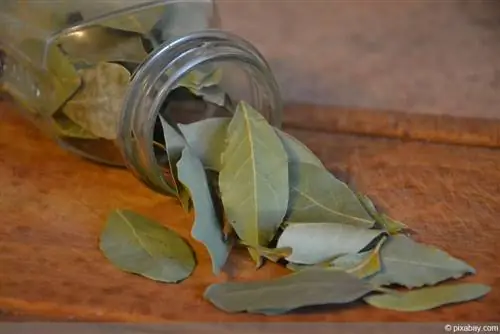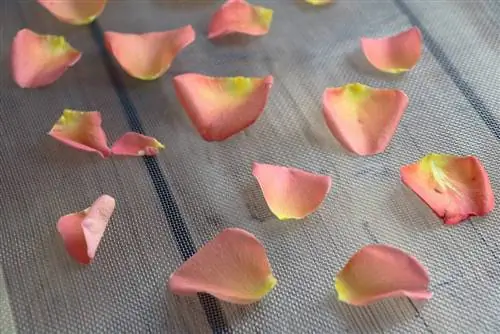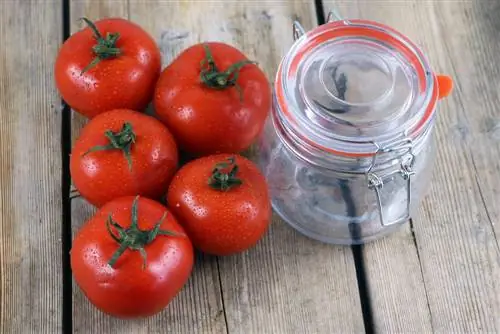- Author admin [email protected].
- Public 2023-12-17 03:39.
- Last modified 2025-01-24 12:45.
The spicy bay leaves can be picked all year round, but there is not always a need for this. However, the leaves can be preserved using various methods so that they can be used months and sometimes even years later. Which preservation option is best depends on various factors. Both individual leaves and entire branches can be dried or frozen.
Harvest
The bay leaves are usually picked from plants that are in their second year of growth. This ensures that it develops sufficiently and that the leaves have their full aroma. Individual bay leaves can be picked all year round, whereas larger quantities are ideally harvested in spring or autumn. Harvesting is relatively simple, but the following should be noted:
- plucking the largest leaves
- these have the most flavor
- Cut branches
- complete shoot tip including the leaves
Tip:
When harvesting whole branches, around 30 leaves can be harvested at once.
Air drying
Drying the bay leaves has several advantages: On the one hand, the shelf life of the leaves is extended enormously because the preserved herbs retain their aroma for up to two years. On the other hand, drying reduces the bitter substances, because fresh bay leaves are significantly more bitter. This in turn results in another positive aspect, because seasoning with dried bay leaf is usually easier. The fresh leaves are much more seasoning, which means that dishes are often over-seasoned. If you want to dry the freshly harvested bay leaves, you have two methods to choose from. However, both variants have the following things in common:
- most gentle way to dry
- do not wash the leaves before drying them
- washing may affect quality
- Remove dust from leaves by shaking
- Temperature not above 35 degrees
- Otherwise the aroma will be affected
Tip:
If the bay leaves are washed before drying, they should always be dabbed with a kitchen paper towel.
Hanging

This method simply involves hanging the entire branches upside down in a dry place. The picked leaves can also be dried in this way, but additional steps are required. The bay leaves must first be “threaded” with a needle and thread before they can be hung up. For both methods, however, the following must be observed during drying:
- Location as warm, sheltered from the wind and dry as possible
- Attics, garden sheds or drying rooms are ideal
- no direct sunlight
- Hang leaves/twigs loosely and next to each other
- Shake bay leaves regularly
- taking apart sticky sheets
- This prevents mold formation
Tip:
It's easy to tell whether the bay leaves are dry: If the leaves still have dark green and/or soft spots, they usually still contain moisture. In such cases it is advisable to let the leaves dry for another week.
Baking tray
The bay leaves can also be dried on a baking tray without much effort. To do this, first spread the leaves on the baking tray with enough space between them. To ensure that the spiced laurel dries evenly, it is important that the leaves are placed next to each other and not on top of each other. The baking tray is then placed in a warm, airy location. The leaves need about two weeks to dry, during which time the following steps are advisable:
- Check leaves regularly
- Turn bay leaves every now and then
- this means they dry evenly
Tip:
The leaves can be prevented from curling by covering them with a cloth. The cloth must then be weighed down, for which a board, for example, is suitable.
Drying using devices

There is not always enough space to air dry the bay leaves. Fortunately, this is not a requirement because the spice leaves can also be dried using technical equipment. In addition, the drying time is significantly reduced with these variants. Because the leaves only need a few hours to dry instead of several weeks. Although the time savings speak for these variants, there is still a disadvantage: In contrast to air drying, the aromas are not protected as much, which is why slight aroma losses are to be expected.
Dehumidifier
- Preheat the device to 35-46 degrees
- Wash the leaves with clean water
- drain excess water
- Dab the leaves with a paper towel
- Distribute leaves to inserts
- Place bets
- let it dry for about 4 hours
Oven
- select lowest temperature level
- optimal temperature range 30-50 degrees
- Line the baking tray with baking paper
- Spread bay leaves on top
- make sure there is enough space and distance
- Do not close the oven completely
- check every now and then
- let it dry for about 2-3 hours
Microwave
- suitable for a few sheets
- Spread the leaves on a plate
- Cover the plate with some kitchen paper
- Set the wattage as low as possible
- no more than 300 watts
- otherwise the leaves will lose their aroma
- let it dry for about 2-3 minutes
- If necessary, dry the leaves with a kitchen paper towel
Tip:
The dried bay leaves can then be chopped up and conveniently stored in spice jars or tin cans.
Freezing

Another method of preserving bay leaves is freezing. The advantage of this variant is that the aromatic substances of the frozen spiced laurel are particularly well preserved. If you want to preserve the spiced laurel in this way, you can freeze both the whole branches and individual leaves. However, before freezing, with this method the leaves must first be washed. These are then freed of excess water and dabbed with a paper towel. The rest of the process differs only minimally depending on whether twigs or leaves are frozen:
Freeze branches
- Spread the branches on the baking tray
- Put the tray in the freezer for 45 minutes
- Remove branches and transfer to freezer bags
- refreeze
Freeze leaves
- Pick leaves and chop if necessary
- Lay out the spiced laurel on the baking tray
- Put the tray in the freezer for about 30 minutes
- Remove the leaves and pour them into freezer bags
- refreeze
Ice cube method
If you not only want to freeze the spiced laurel, but also practically portion it in the same step, you can preserve it in ice cube trays. All you need is the fresh bay leaves and an ice cube tray. This preservation method requires a little more effort, but it is only a one-off:
- chop fresh leaves
- Fill herbs into ice cube tray
- Fill container with water
- Herbs should be covered
- optimal is 2/3 herbs to 1/3 water
- then freeze ice cube tray
Tip:
The herb ice cubes can be used whole for seasoning and do not need to be defrosted beforehand!






